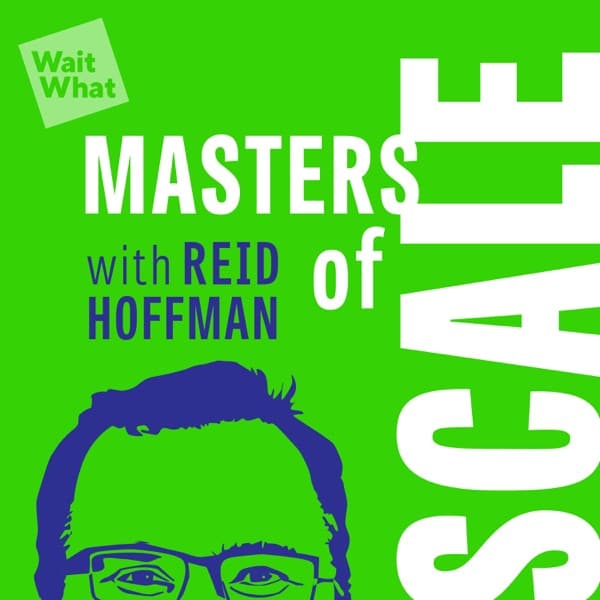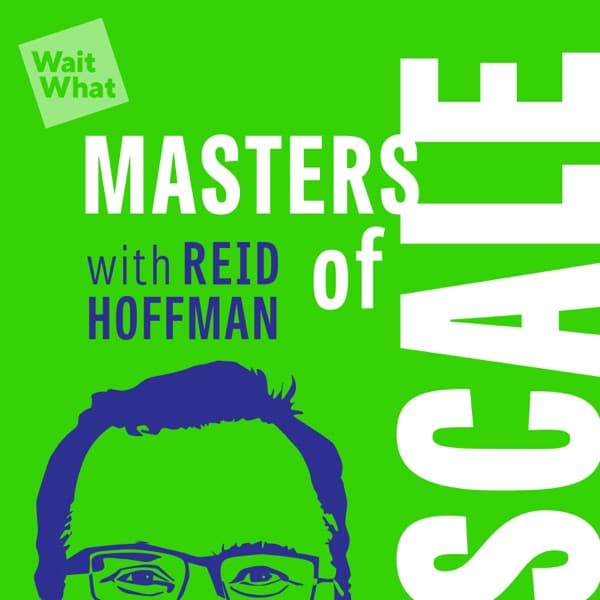Fireship: The UK demands Apple create a backdoor to access encrypted iCloud data, challenging global privacy.
TechCrunch: The podcast discusses Andreessen Horowitz's controversial hire, Stripe's strategic moves, a merger in the space industry, and Elon Musk's influence in the US government.
The Twenty Minute VC (20VC): Venture Capital | Startup Funding | The Pitch: Brian Tolkien, head of product at Opendoor, shares insights on product strategy, lessons from Uber, and the evolving role of product managers in an AI-driven world.
Masters of Scale: Reid Hoffman discusses the potential and risks of AI, emphasizing its transformative impact on industries and society.
Fireship - UK demands backdoor for encrypted Apple user data...
The UK government has issued a technical capability notice to Apple, demanding the creation of a backdoor to access users' encrypted iCloud data globally. This demand is part of the UK's broader surveillance efforts under the Investigatory Powers Act of 2016, which grants extensive data access capabilities to intelligence agencies. The notice is controversial because it challenges the privacy protections offered by Apple's Advanced Data Protection service, which uses end-to-end encryption, meaning only users have the keys to their data. The UK government's demand is seen as a threat to global privacy, as it could set a precedent for other countries to follow. Apple has historically resisted such demands, as seen in their refusal to unlock an iPhone for the FBI in 2016. The video suggests that Apple might negotiate a compromise, potentially discontinuing the service in the UK. For users concerned about privacy, the video recommends using end-to-end encrypted apps, full disk encryption, VPNs, and the Tor browser to protect their data.
Key Points:
- UK demands Apple create a backdoor for iCloud data access.
- Apple's Advanced Data Protection uses end-to-end encryption.
- UK's Investigatory Powers Act enables extensive surveillance.
- Apple historically resists government data access demands.
- Users should use encryption tools and VPNs for privacy.
Details:
1. 🔍 British Empire's Demand for Backdoor Access
- The British Empire issued a secret technical capability notice to Apple, mandating the creation of a backdoor to access users' encrypted iCloud data globally.
- This demand raises significant concerns around user privacy and data security, challenging Apple's commitment to encryption and privacy.
- Apple's response has been one of resistance, emphasizing their dedication to user privacy and encryption without compromises.
- The legal framework for such demands is complex and often involves balancing national security interests with individual privacy rights.
- This demand is part of a broader trend of governments seeking increased access to encrypted communications, reflecting ongoing tensions between privacy advocates and law enforcement.
2. 🔓 Global Implications for Encrypted Apps
- The shift affects not only specific regions but has worldwide implications for all users who can afford Apple products, indicating a significant global shift in privacy expectations and user security.
- The announcement serves as a crucial warning for users of end-to-end encryption apps like Telegram, Signal, and WhatsApp, highlighting potential risks and the need for increased awareness and security measures.
- This change prompts a reevaluation of how encrypted communication apps operate globally, emphasizing the necessity for companies to adapt their strategies to maintain user trust and compliance with varying regional laws.
- For example, countries with strict data privacy laws could see increased scrutiny on these apps, potentially leading to changes in how companies handle user data and encryption.
- As global digital privacy concerns rise, users and companies alike must stay informed about policy changes and their implications on personal and professional communications.
3. 🕵️ UK Surveillance and Legal Secrecy
- The UK Investigatory Powers Act of 2016 grants MI5 and MI6 extensive 'god mode' hacking capabilities, allowing them to bypass digital security measures.
- Internet service providers are mandated to retain records of all websites visited by users, enabling comprehensive mass surveillance.
- It is illegal for companies like Apple to disclose government surveillance demands, highlighting a significant level of legal secrecy and lack of transparency.
- The law's broad scope raises concerns about privacy and civil liberties, as it allows extensive monitoring without public scrutiny.
- In comparison, countries like Germany have stricter oversight and limitations on surveillance, emphasizing the UK's unique approach to national security.
- The Act's implications for digital privacy set a precedent in international surveillance practices and challenge existing norms in data privacy.
4. 🔐 Understanding iCloud Encryption
- The segment explores the implications of encryption for iCloud users, emphasizing the importance of end-to-end encryption in safeguarding private data.
- The technology behind end-to-end encryption is described as amazing and essential for privacy protection.
- The segment humorously suggests preventing even a figure like James Bond from accessing your private data, highlighting the strength of encryption.
5. 🔑 Apple's Encryption Methods and Government Concerns
- Apple's iCloud data storage reaches the exabyte scale, indicating the vast amount of data stored.
- Data in iCloud is encrypted both in transit and at rest, ensuring security during upload and storage.
- Private keys for decryption are stored in Apple's data centers, making them theoretically accessible under government pressure.
- Government access to data is a concern due to potential legal obligations Apple may face to provide access to iCloud contents.
- Apple's approach emphasizes user privacy, but storing decryption keys within their data centers poses a risk if compelled by governments to release them.
- Apple's strong encryption has been a point of contention with law enforcement agencies seeking access to user data for legal investigations.
6. 🛡️ Advanced Data Protection and Its Challenges
- Apple's Advanced Data Protection service, launched in 2022, employs end-to-end encryption, empowering users to manage and control their own encryption keys, thus ensuring that even Apple cannot access their data.
- A critical challenge associated with this service is the potential for data loss if users lose their encryption keys, highlighting the need for robust key management strategies by users.
- The evolution of end-to-end encryption includes technologies like the double ratchet algorithm, used by apps such as Signal and WhatsApp, which ensures forward secrecy and prevents the decryption of past or future messages if a key is compromised.
- The implementation of advanced encryption poses significant challenges to government surveillance, with limited options for access unless advancements in quantum computing occur that could potentially break current encryption standards.
- Implications for users include a higher responsibility for managing their encryption keys securely, and the broader impact on privacy and government access to information.
- Future developments in encryption technology may further enhance data protection but also complicate access for legitimate surveillance needs.
7. ⚖️ Apple's Stance Against Government Pressure
- Apple has historically resisted government pressure to compromise user data privacy, as seen in 2016 when they refused to create an iOS backdoor for the FBI even after the San Bernardino shooting.
- The FBI had to resort to paying a third party over a million dollars to access the phone, highlighting Apple's commitment to user privacy.
- Apple is unlikely to comply with technical capability notices that compromise data security, potentially reaching a compromise that involves discontinuing certain services in specific regions.
8. 🔒 Privacy Measures and Tools for Users
- Utilize end-to-end encryption for all communications, using apps like Signal.
- Implement full disk encryption on your hard drive for enhanced data protection.
- Use a trusted VPN with a strict no-logs policy to maintain anonymity online.
- Access the internet through the Tor browser over the Onion Network to anonymize traffic, noting that ISPs in the UK are required to track website visits.
- Consider using Tails OS, an amnesic operating system, which runs off a USB and wipes memory to prevent data retrieval after shutdown.
9. 📚 Learning Cybersecurity with Brilliant
- Brilliant offers free access to learning math and computer science concepts, essential for cybersecurity, through engaging lessons.
- The platform recommends starting with math courses suitable for all levels and progressing to applied Python courses for practical cybersecurity skills.
- Users can form a daily learning habit with short, rewarding lessons, accessible via phone, requiring only a few minutes each day.
- A 30-day free trial is available through brilliant.org/fireship, allowing users to explore all offerings.
TechCrunch - Are companies falling out of love with OpenAI?
The podcast begins with a discussion on Andreessen Horowitz's surprising hire of Daniel Penny, a controversial figure due to his past legal issues. This move is seen as a signal to align with certain political bases, despite Penny's lack of investment experience. The conversation then shifts to Stripe's recent hire of Asia Broadley, indicating a potential focus on startup acquisitions and partnerships, possibly hinting at future public offerings. The podcast also covers a merger between two space startups, Our Sky and PlaneWave, forming Observable Space. This merger combines software and hardware capabilities, aligning with the American dynamism movement by focusing on domestic manufacturing. Lastly, the podcast touches on Elon Musk's influence in the US government, highlighting concerns over transparency and the involvement of inexperienced individuals in sensitive roles. The episode concludes with a discussion on AI developments, particularly Figure's decision to develop its own AI models, moving away from OpenAI, and the challenges OpenAI faces in monetizing its technology.
Key Points:
- Andreessen Horowitz hired Daniel Penny, signaling political alignment despite his lack of investment experience.
- Stripe's hire of Asia Broadley suggests a focus on startup acquisitions and potential public offerings.
- Observable Space merger combines software and hardware, aligning with American dynamism and domestic manufacturing.
- Elon Musk's influence in US government raises transparency and security concerns.
- Figure develops its own AI models, highlighting challenges for OpenAI in monetizing its technology.
Details:
1. 🎧 Welcome to Equity Podcast
- The segment consists entirely of music with no spoken content, hence there are no actionable insights, metrics, or data points available.
2. 🕵️♂️ Andreessen Horowitz's Controversial Hire
- Andreessen Horowitz has hired Daniel Penny, who was charged with manslaughter and criminally negligent homicide in 2023 after fatally choking another passenger on the subway.
- Daniel Penny was acquitted of the charges but the incident was a significant news story at the time.
- The decision to hire Penny has sparked controversy and debate within the industry and public, raising questions about corporate responsibility and due diligence in hiring practices.
- Public reaction has been mixed, with some defending the decision based on Penny's acquittal, while others argue it is insensitive and damaging to the firm's reputation.
- This hiring decision could impact Andreessen Horowitz's brand image, investor relations, and stakeholder trust, highlighting the complex interplay between legal outcomes and public perception.
3. 💼 Stripe's Strategic Moves in Startups and Acquisitions
- Stripe partners with Andreessen Horowitz's American Dynamism team to invest in defense tech and gov tech, targeting sectors with strong government ties, indicating a shift towards public sector engagement.
- The collaboration emphasizes leveraging connections to the Department of Defense, showcasing a strategic alignment with government-oriented projects.
- Appointments within this initiative suggest a move away from traditional investor backgrounds, possibly to align more closely with certain political demographics.
- This strategic investment indicates Andreessen Horowitz and Stripe's expanding role in government-related sectors, potentially influencing shifts in tech investment trends.
4. 🚀 Space Tech Mergers and American Dynamism
4.1. Stripe's Strategic Moves
4.2. Space Startups Merger and American Dynamism
5. 🚗 Cruise's Robotaxi Program Shuts Down
- Cruise laid off 50% of its workforce, approximately 1,000 employees, indicating a significant operational shift.
- The company is being absorbed into its parent company, GM, which signals a strategic pivot towards enhancing GM's Advanced Driver Assistance Systems instead of focusing on autonomous taxis.
- GM had previously communicated its intention to cease funding the Robo taxi initiative, suggesting that the shutdown was anticipated as part of a broader strategic realignment.
- The departures of the co-founder and CEO of Cruise underscore the magnitude of these strategic changes.
- This move reflects GM's decision to prioritize immediate technological advancements in driver safety and assistance systems over the longer-term vision of fully autonomous vehicles.
- The shift may impact the competitive landscape, with GM potentially leveraging its existing technology and infrastructure to gain an advantage in the driver assistance market.
6. 🤯 Elon Musk's Influence in U.S. Government
6.1. Cultural Shift and Employment Dynamics in DC
6.2. Controversial Influence and Public Perception
6.3. Security Concerns and Governance Implications
7. 🤖 AI Innovations and OpenAI's Challenges
7.1. Humanoid Robotics and OpenAI's Strategic Shift
7.2. AI Applications and Business Model Exploration
7.3. Market Dynamics and Emerging Competitors
8. 🎤 Farewell and Upcoming Episodes
- Equity podcast will return next week with new episodes.
- Listeners can follow the podcast on social media under the handle @EquityPod on X and Threads.
- The production of Equity is managed by Teresa Loon Solo with editing by Kell.
- Acknowledgment was given to TechCrunch's audience development team.
The Twenty Minute VC (20VC): Venture Capital | Startup Funding | The Pitch - 20Product: Product Secrets Behind Uber and Opendoor | How AI Changes the Role of the PM & The Product Development Process | How to Hire the Best Product Teams & What No One Does That Everyone Should Do with Brian Tolkin

Brian Tolkien discusses his experiences at Uber, particularly the challenges of launching Uber Pool in China, emphasizing the importance of understanding product components and cultural differences. He highlights the need for good mapping and routing data, which was a challenge in China due to the lack of Google Maps. Brian also reflects on product decisions, such as the default setting of Uber Pool, which prioritized business needs over user preferences, teaching him the importance of balancing both.
He explores the changing role of product managers in the context of AI, noting that while tools and processes may evolve, the core responsibilities of understanding user needs and aligning them with business goals remain constant. Brian emphasizes the importance of simplification in product management and the need to focus on core user needs amidst various pressures. He also discusses the significance of hiring the right PMs for specific team needs and the benefits of staying longer at a company to gain deeper insights and effectiveness.
Key Points:
- Understand the core components of your product and adapt to cultural differences when expanding internationally.
- Balance business needs with user preferences to avoid poor product decisions.
- AI will change tools and processes, but core PM responsibilities remain the same: understanding user needs and business alignment.
- Simplification is key in product management; focus on core user needs despite external pressures.
- Hiring the right PMs for specific team needs is crucial; staying longer at a company enhances effectiveness.
Details:
1. 🎙️ Welcome to 20 Product: Meet Your Host
1.1. Introduction to 20 Product
1.2. Guest Introduction: Brian Tolkien
2. 🚀 Brian's Career: From Uber to Opendoor
- Brian served as head of product at Opendoor for six years, where he successfully implemented strategic product innovations that led to significant company growth.
- At Opendoor, Brian managed a team of product and design professionals, enhancing the company's product offerings and customer experience.
- Prior to Opendoor, Brian spent five years at Uber, contributing to its most substantial growth period. His work included scaling operations and optimizing product strategies.
- At Uber, Brian played a pivotal role in launching new features and improving the user interface, significantly boosting user engagement and satisfaction.
3. 🔍 AI and Enterprise Solutions: Turing and WorkOS
3.1. Turing's Technological Capabilities
3.2. Turing's Market Positioning and Partnerships
4. 🛡️ Enterprise Security Simplified with WorkOS
- WorkOS offers a modern identity platform tailored for B2B SaaS companies aiming to sell to enterprises.
- Key enterprise security features include SAML for secure authentication, single sign-on (SSO) for seamless access, SCIM for user provisioning, and audit logs for tracking and compliance.
- These features are crucial for meeting enterprise security standards which are often complex and time-consuming to implement.
- WorkOS streamlines the integration process, reducing development time from months to weeks, thus accelerating time-to-market for startups.
5. 🔍 Pendo: Revolutionizing Product Experience
5.1. Streamlined Enterprise Readiness
5.2. Comprehensive User Management and Enterprise Integration
5.3. Trusted by Leading Companies
5.4. Significant Funding & Market Confidence
6. 🚗 Inside Uber: Lessons from China Launch
- Uber faced significant challenges when entering the Chinese market, including competition from local giants like Didi.
- To compete, Uber implemented localized strategies, such as forming partnerships with local companies and customizing their app experience to meet Chinese user preferences.
- Despite aggressive investment and localization efforts, Uber eventually sold its China operations to Didi Chuxing, reflecting the intense competition and market dynamics.
- The China experience taught Uber valuable lessons in market adaptation, strategic partnerships, and the importance of understanding local consumer behavior.
7. 💡 Product Strategy: Learning from Uber
- The China Pool Uber launch was crucial for competing with Didi in major cities, emphasizing the necessity of local adaptations.
- Significant technical challenges were faced, such as establishing a Chinese data center and ensuring system functionality just before launch.
- The launch in Chengdu, a city with 20 million people, was strategically timed for rush hour to maximize liquidity and improve match efficiency.
- Key product lessons included understanding critical components for product functionality, particularly ride match quality and pricing, which directly impacted user satisfaction.
- Challenges included the lack of Google Maps, requiring innovative solutions for mapping and routing, illustrating the need for adaptable technology strategies.
- The launch's success was measured by user adoption rates and market share changes, highlighting the importance of strategic timing and technical readiness.
8. 🧐 Balancing Act: User Needs and Business Goals
8.1. Cultural Differences in Product Design
8.2. Globalization's Impact on Design Convergence
8.3. Product Decisions and User Experience Impact
9. 🌐 PM Role Evolution in the AI Era
- The role of the PM is evolving significantly with AI, requiring a balance between user needs and business needs.
- AI is changing the tools and methods used by PMs, moving from writing PRDs to building quick demos due to AI's ability to make development faster and cheaper.
- Despite changes in tools, the core responsibilities of PMs remain: engaging with users, understanding their needs, and aligning product development with business objectives.
- The challenge remains in synthesizing diverse information sources—customer feedback, CX team insights, user interviews, and data analytics—to make effective product decisions.
10. 🗺️ Product Development: Process and Prioritization
10.1. Decision-making in Product Development
10.2. Prototyping Tools and Workflow Transformation
10.3. AI's Role in Accelerating Product Development
10.4. Effective One-Pager Attributes
10.5. Prioritization Framework
11. 📈 Growth vs. Technical Debt: Strategic Insights
- Prioritizing between building new features, stabilizing existing ones, or paying down technical debt is a core strategic challenge that persists even when a company goes public.
- For early-stage companies aiming for aggressive growth (e.g., from $2 million to $8 million ARR), focusing on new product expansion is often prioritized over paying down technical debt, as the primary goal is to 'earn the right to exist in the future.'
- In competitive markets or 'land grabs,' such as Uber's scenario, the priority is often to capture market share quickly rather than focus on technical debt.
- At early stages, determining whether the product truly has market value and demand is crucial, and technical debt is often secondary to proving market fit.
- In early-stage companies, the CEO often assumes the role of the Chief Product Officer (CPO) to maintain strategic alignment and focus, although this may change as the company scales.
12. 🔄 Expanding Horizons: Single to Multi-Product
- Outsourcing product development during early stages is risky if the product is the company's key asset; internal development helps retain control and quality.
- Maintaining core product integrity is crucial; avoid the innovator's dilemma by keeping the core product's value intact while innovating.
- Utilize sandboxes for new product development to prevent negative impacts on the core product, as practiced by Uber and Opendoor.
- New products should leverage the company's existing competitive advantages rather than necessarily benefiting the original product.
- Employ a strategic two-by-two matrix to decide between targeting new customer sets or leveraging core capabilities, enhancing strategic clarity.
- Prioritize overall customer experience and business performance improvements, even if the core product remains static.
- Real-world example: Uber used a sandbox approach to develop Uber Eats, ensuring their core ride-sharing service remained unaffected.
13. 🎯 Simplification in Product Management
- Transitioning from a single product to multi-product offerings can harm user experience, as seen with Uber's shift from UberX to UberPool.
- Opendoor's initial focus on expanding into new customer sets and capabilities could have been more effective by leveraging core strengths with existing customers.
- Companies should focus on simplifying product offerings, emphasizing 'kernels of truth' amidst complex demands and pressures.
- A successful product management strategy involves identifying what truly matters to the user, such as Uber's focus on availability, speed, and reasonable pricing.
- Aligning priorities to enhance key product dimensions is crucial, despite various feedback and potential solutions.
- Determining key objectives and results (OKRs) is essential, with roles like CEO, CPO, or head of product potentially setting these priorities.
14. 🔄 OKRs and Prioritization: Best Practices
14.1. OKRs Alignment and Cascading
14.2. Common Mistakes and Best Practices in OKRs
14.3. Focus and Strategic Decisions
14.4. Adaptability and Skill Sets in Company Growth
15. ⚖️ Speed vs. Refinement: A Product Leader's Dilemma
15.1. OKRs and Strategic Planning
15.2. Balancing Speed and Refinement
15.3. Evaluating Product Changes and User Adaptation
16. 🛠️ Building Teams: Hiring and Dynamics
16.1. Gut-driven vs Data-driven Leadership
16.2. Simplicity in Product Design
16.3. Balanced Leadership: Consensus vs Decisiveness
16.4. Strategic Hiring for Product Teams
17. 🔍 Managing Momentum and Cross-Functional Challenges
17.1. Hiring Challenges and Solutions
17.2. Effective Interview Process
17.3. Sprint Management and Team Alignment
17.4. Role of Background and Skills in PM Hiring
17.5. Operational Challenges in Product Management
18. 🔄 Career Longevity and Growth
18.1. Revitalizing Team Dynamics
18.2. Strategic Prioritization
18.3. Building Hype and Goodwill
18.4. Maximizing Career Longevity
19. 👶 Personal Insights: Quickfire Round
19.1. Startup vs Big Company
19.2. Parenting Advice
19.3. Product Market Fit
19.4. Hiring Insight
19.5. Best Product Decision
19.6. Product vs Operations
19.7. Consumer Wow Moments
19.8. Future of Product
20. 🗣️ Conclusion and Sponsor Highlights
20.1. Turing: Enhancing AI Capabilities
20.2. WorkOS: Simplifying Enterprise Readiness
20.3. Pendo: Transforming Product Experiences
Masters of Scale - Pivot: Reid Hoffman joins Kara Swisher and Scott Galloway to go deep on AI news

Reid Hoffman, co-founder of LinkedIn, discusses the transformative potential of AI, highlighting its ability to revolutionize industries such as healthcare and education by providing affordable, high-quality services. He envisions AI as a tool for creating immense value for humanity, likening it to a cognitive industrial revolution. Hoffman acknowledges the risks associated with AI but remains optimistic about its future, advocating for intelligent navigation of these challenges. He also addresses the competitive landscape of AI, suggesting that while there will be significant public benefits, the industry may not see a few dominant winners as in past tech revolutions. Instead, he predicts a diverse ecosystem of companies contributing to AI's growth. Hoffman also touches on the societal implications of AI, including its role in enhancing mental health through empathetic AI agents. He stresses the importance of maintaining American leadership in AI development amidst global competition, particularly from China.
Key Points:
- AI can revolutionize healthcare and education by providing affordable, high-quality services.
- Hoffman is optimistic about AI's future, despite acknowledging potential risks.
- The AI industry may not have a few dominant winners; instead, a diverse ecosystem of companies will emerge.
- AI can enhance mental health through empathetic AI agents.
- Maintaining American leadership in AI is crucial amidst global competition.
Details:
1. 🎙️ Introduction & Podcast Teaser
- Reid Hoffman joins the Pivot podcast hosted by Kara Swisher and Scott Galloway.
- The discussion focuses on the hype and fears surrounding DeepSeek, a trending topic.
- Reid Hoffman emphasizes the importance of investing in AI, highlighting its potential impact.
- The podcast aims to explore current issues in technology and business, providing insights from industry leaders.
2. 🎧 Reid Hoffman Joins Pivot
- The transcript includes mentions of subscribing to the Pivot podcast featuring Kara Swisher and Scott Galloway.
- There is positive feedback from an audience member named Amanda, indicating strong engagement with the content.
- Reid Hoffman, a notable guest, joins the podcast, suggesting high-profile discussions likely.
- The episode may cover topics relevant to entrepreneurship, technology, and business strategy, given Reid Hoffman's expertise and background.
3. 🚨 Tragic Air Crash Discussion
- The crash at Reagan Airport in D.C. on Wednesday night is the worst air disaster in over 15 years.
- An American Airlines regional plane with 64 people on board collided in midair with a Blackhawk helicopter carrying three soldiers.
- The incident resulted in no survivors, as confirmed by authorities.
- Authorities have begun an investigation to determine the cause of the collision, focusing on air traffic control communications and flight data recorders.
- The crash has prompted FAA to review safety protocols concerning mixed aircraft operations near busy airports.
4. 🔍 Air Travel Safety & Public Reaction
- 28 bodies have been recovered from the crash site, marking a tragic incident.
- Authorities are actively investigating to determine the cause of the crash, emphasizing the need for a thorough and unbiased inquiry.
- Public discourse stresses the importance of not politicizing the tragedy or engaging in unsubstantiated online speculation.
- Despite the tragedy, air travel remains remarkably safe, with this incident being the worst in over 15 years.
- In contrast, automobile accidents, which are less publicized, result in about 800 deaths weekly in the U.S., highlighting a discrepancy in public perception of transportation safety.
- The general public reaction reflects amazement at the overall safety of air travel, suggesting a perspective that appreciates the rarity of such incidents.
5. ✈️ FAA's Role & System Acknowledgment
- Flying is statistically safer than driving, showcasing the effectiveness of the FAA and the air transport system. The FAA's regulations and oversight have significantly reduced aviation incidents. For example, the implementation of advanced safety protocols and continuous monitoring has led to a decrease in accidents by over 50% in the past decade. These efforts ensure that air travel remains the safest mode of transportation, reflecting the FAA's commitment to passenger safety.
6. 🤖 Optimism in AI's Future
6.1. System Accountability
6.2. Diversity and Workforce Concerns
6.3. Unusual Incident Context
7. 📈 AI's Economic Impact & DeepSeek Analysis
- AI can enable a medical assistant that is superior to the average GP available on every smartphone, operating for under $5 an hour, revolutionizing healthcare accessibility.
- AI offers the potential for a personalized tutor on every subject for every age group, enhancing educational accessibility and effectiveness.
- The cognitive industrial revolution driven by AI is expected to significantly boost productivity across various sectors, reshaping economies.
- The 'cost to zero' concept, though debated, suggests technology may drastically reduce costs, impacting market dynamics.
- AI's integration into healthcare and education represents specific, actionable opportunities for economic growth and societal benefit.
8. 💼 AI Industry Speculations & Public Benefit
8.1. Industry Value Distribution
8.2. AI Market Dynamics and Major Players
9. 🔬 DeepSeek's Market Impact & Speculations
9.1. Market Frenzy and Investigations
9.2. Model Creation and Speculations
9.3. Cost and Talent Considerations
9.4. Performance and Scale
10. 💸 AI Investments & Economic Implications
- NVIDIA experienced market fluctuations, illustrating the volatile nature of AI investments, yet managed to recover, underscoring the resilience needed in this sector.
- Major investments, such as Microsoft's $80 billion commitment, highlight the significant scale and long-term focus required for impactful AI integration.
- AI investments often range from $50 billion to $80 billion, indicating the substantial financial resources major players are willing to allocate.
- The debate on short-term versus long-term payoffs suggests AI investments may take 5 to 7 years to realize significant returns.
- Industry leaders view AI investments as crucial, despite the heavy financial commitments, due to their potential to drive future growth and innovation.
- AI is seen as a strategic area for national competitiveness, especially amid U.S.-China relations, emphasizing its importance not just technologically but geopolitically.
- The speaker emphasizes that AI investments should be viewed as a strategic national asset, crucial for maintaining competitive advantage on a global scale.
11. 🛒 Consumer Market Dynamics & Superagency
11.1. China's IP Theft and AI's Impact
11.2. Bifurcation in Consumer Markets
11.3. Agent Proliferation in Future Markets
11.4. AI in Drug Discovery
12. 🌱 AI's Role in Health & Broader Applications
12.1. Superagency and AI's Amplifying Power
12.2. AI in Health and Human Condition
12.3. Investment and Broader Applications
13. 📰 Meta Settlement & Political Pressure
13.1. Settlement Details
13.2. Allocation of Settlement Funds
13.3. Negotiations and Pressure
13.4. Concerns Over Payoffs
13.5. Shareholder Perspective
13.6. Societal Implications
13.7. Platform Rights
14. 🇺🇸 Personal Safety & Political Dynamics
14.1. State Power and Individual Interests
14.2. Security and Political Opponents
14.3. Criticism and Patriotism
15. 🏢 Government Layoffs & Organizational Change
15.1. Government Employee Resignation Offer
15.2. Comparison to Elon Musk's Strategies
15.3. Challenges of Applying Private Sector Strategies to Government
15.4. Need for Organizational Refactoring
16. 💳 Innovation in Payments & Financial Trust
16.1. Real-time Payments with xMoney and Visa Partnership
16.2. Current State and Innovation in Payment Systems
17. 🔄 Transition to AI's Social Impact
- Twitter's potential integration into financial systems highlights a lack of traditional trust mechanisms like FDIC insurance, underscoring the need for secure protocols.
- Although technology like Twitter offers innovative possibilities for financial transactions, the current infrastructure lacks the necessary trust.
- Innovations in funding and payments prioritize usability and integration, with Apple leading in consumer ease of use for payments.
- Stripe has advanced global entrepreneurship by simplifying the process of incorporating businesses through Delaware corporations.
- The concept of 'trustless trust' in crypto seeks to establish decentralized systems, yet hasn't gained the widespread traction of traditional payment systems such as Apple Pay.
- Globally, AI is transforming financial systems by offering new ways to secure transactions and streamline business operations, though challenges in trust and regulation remain.
18. 🤔 RFK Jr.'s Confirmation & Public Health Concerns
18.1. RFK Jr.'s Stance and Controversial Statements
18.2. Family Concerns and Criticism
18.3. Public Health Risks and Industry Support
19. 🔮 Predictions & AI's Future in Mental Health
19.1. Inclusion of New Media in White House Briefings
19.2. AI Cost Reduction and Industry Impact
19.3. AI's Positive Impact on Mental Health
20. 🛡️ AI Ethics & Safeguarding Society
20.1. Ethical Challenges in AI for Mental Health
20.2. AI-Generated Content and Free Speech
Included Channels
 Masters of Scale
Masters of Scale Lex Fridman Podcast
Lex Fridman Podcast All-In with Chamath, Jason, Sacks & Friedberg
All-In with Chamath, Jason, Sacks & Friedberg Modern Wisdom
Modern Wisdom a16z Podcast
a16z Podcast Lenny's Podcast: Product | Growth | Career
Lenny's Podcast: Product | Growth | Career No Priors AI
No Priors AI The Twenty Minute VC (20VC): Venture Capital | Startup Funding | The Pitch
The Twenty Minute VC (20VC): Venture Capital | Startup Funding | The Pitch How I Built This with Guy Raz
How I Built This with Guy Raz BG2Pod with Brad Gerstner and Bill Gurley
BG2Pod with Brad Gerstner and Bill Gurley TechCrunch Startup News
TechCrunch Startup News Y Combinator Startup Podcast
Y Combinator Startup Podcast





